Key takeaways:
- Healthcare education combines theory and real-life scenarios to enhance critical thinking, decision-making, and emotional resilience in practitioners.
- Scenario-based training fosters teamwork and communication skills, essential for effective patient care in high-pressure situations.
- Immediate feedback during simulations allows for reflection and growth, creating a safe learning environment that better prepares students for real-world challenges.
- Practicing empathetic communication and understanding diverse patient needs are crucial for delivering compassionate care and improving patient outcomes.
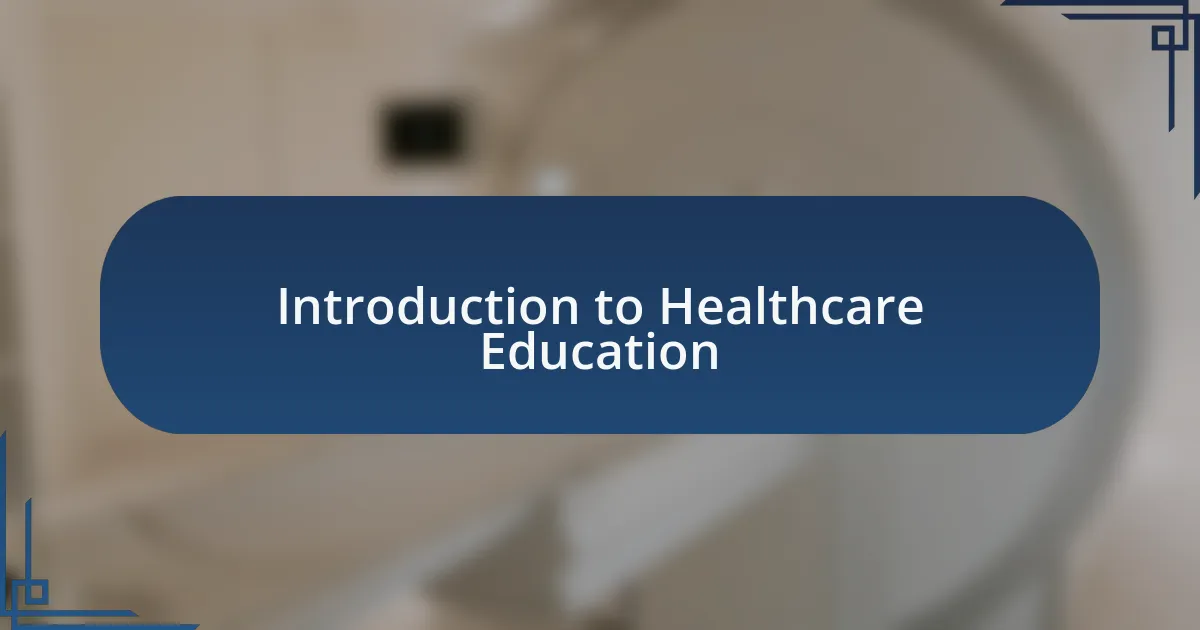
Introduction to Healthcare Education
Healthcare education is the cornerstone of effective patient care and safety. I still vividly remember my first day of training; the gravity of what we were about to learn hung in the air. It sparked a realization in me about the impact of our future knowledge on real lives.
As I delved deeper into the curriculum, I often found myself questioning standard practices. Why do we do things a certain way? The answers helped shape my understanding and commitment to excellence. This process of inquiry not only fueled my passion but also fostered a culture of critical thinking among my peers.
Healthcare education goes beyond textbooks; it encompasses simulations and real-world applications that prepare us for the unexpected. I recall a scenario-based training session that challenged our team dynamics and decision-making under pressure. It was that moment I understood that our training needed to reflect the evolving nature of healthcare challenges.
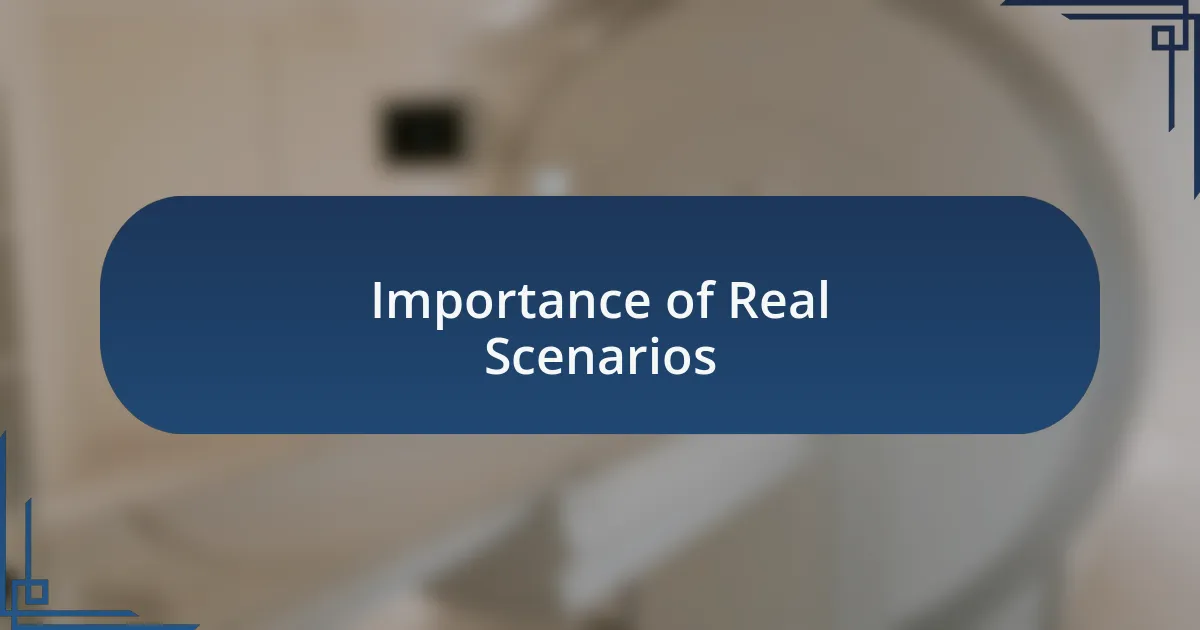
Importance of Real Scenarios
Real scenarios in healthcare training are crucial because they bridge the gap between theory and practice. I remember during a simulation exercise where we had to respond to a mock emergency. The adrenaline rush was palpable, and I could feel my heart racing as I applied what I had learned. That experience was invaluable as it revealed how theoretical knowledge comes alive in high-pressure situations.
Engaging with real-life scenarios helps to develop critical thinking and problem-solving skills that are essential in the healthcare field. For instance, I encountered a case study involving a patient with multiple health issues. Analyzing that situation demanded not just technical knowledge, but also empathy and creative solutions to balance their complex needs. It reinforced the idea that real-life applications make us more adaptable and responsive practitioners.
These training sessions foster emotional resilience, preparing us for the realities of working in healthcare. In one particularly poignant simulation, we simulated end-of-life care discussions. This exercise struck a chord with me, reminding me that these conversations are not just tasks but deeply emotional moments for patients and families. It taught me to approach difficult dialogues with compassion, preparing me for the sensitive nature of real-life scenarios.
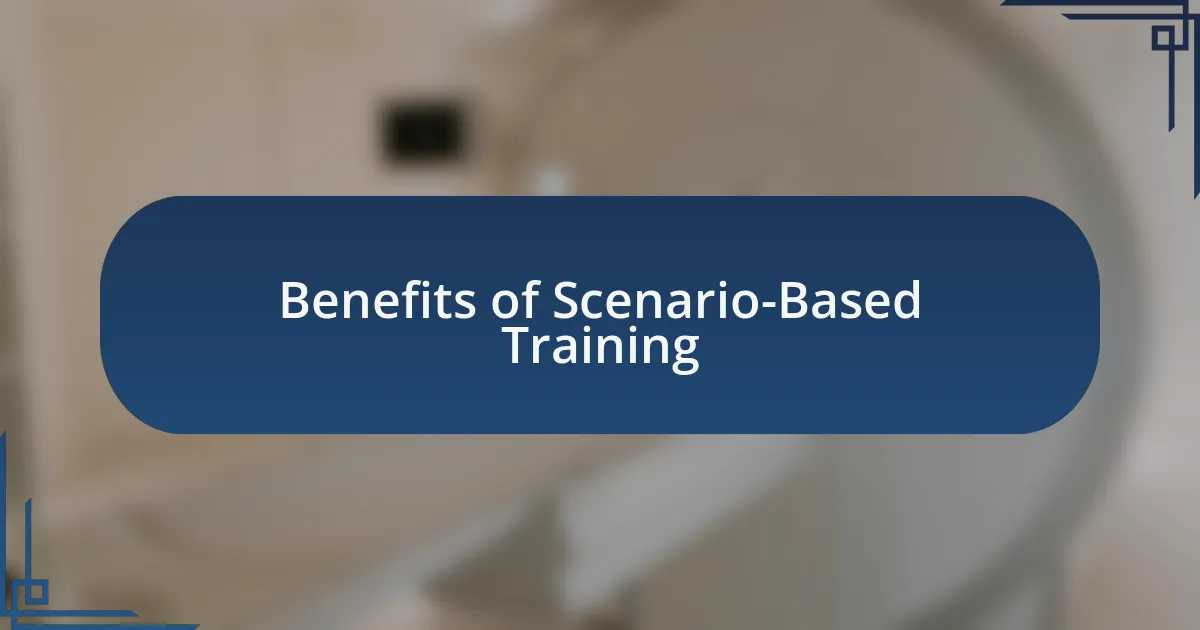
Benefits of Scenario-Based Training
One significant benefit of scenario-based training is that it enhances decision-making under pressure. I remember a scenario where we simulated triaging multiple patients. The chaos made me realize just how important it is to assess situations quickly and prioritize effectively. In those moments, I often ask myself: how can I make the best choice with limited information? This training helps us learn that making tough decisions can be improved through practice.
Additionally, these scenarios encourage teamwork and communication among healthcare professionals. During a particularly intense simulation, our team had to work together to manage a critical care patient. I found that clear communication was vital. It’s fascinating how such experiences drive home the point that collaboration not only improves patient outcomes but also builds trust among team members. After all, who hasn’t found themselves wishing for a moment of clarity in the midst of chaos?
Moreover, scenario-based training fosters a sense of confidence and preparedness that theoretical learning often lacks. I distinctly remember feeling uncertain before my first real clinical encounter. However, after engaging in several simulations, I noticed a shift in my mindset. It was as if I had transformed from a hesitant novice into a more assured practitioner. Isn’t it reassuring to think that we can systematically build our abilities through well-structured practice? That’s the real strength of scenario-based training; it equips us to face challenges head-on.

Implementing Real Scenarios in Training
Implementing real scenarios in training requires a thoughtful design that mirrors the challenges healthcare professionals face daily. I recall a training session where we worked through a simulated emergency response to a cardiac arrest. Walking into that simulation, I felt a mix of anxiety and excitement—the stakes felt real, and every decision mattered. This kind of immersion can spark a deeper understanding that theoretical classes simply can’t replicate.
One of the most impactful aspects of using real scenarios is the opportunity for immediate feedback. During a debrief after a particularly challenging exercise, I remember receiving constructive critiques from both my peers and instructors. This exchange added layers to my learning experience. How often do we get the chance to reflect on our actions and learn from them in real time? I believe this feedback loop cultivates a safe space for making mistakes, leading to growth and better performance when it truly counts.
It’s essential to incorporate a variety of scenarios that reflect the diversity of patient experiences. In one session, we role-played a culturally sensitive interaction with a patient from a different background. Initially, I felt uncertain about how to approach the conversation. However, by practicing, I realized that empathy and understanding significantly enhance patient care. How can we expect to serve our communities effectively if we don’t practice these nuanced interactions? Realistic scenarios allow us to confront these complexities and prepare ourselves for the myriad of situations we might encounter in our careers.
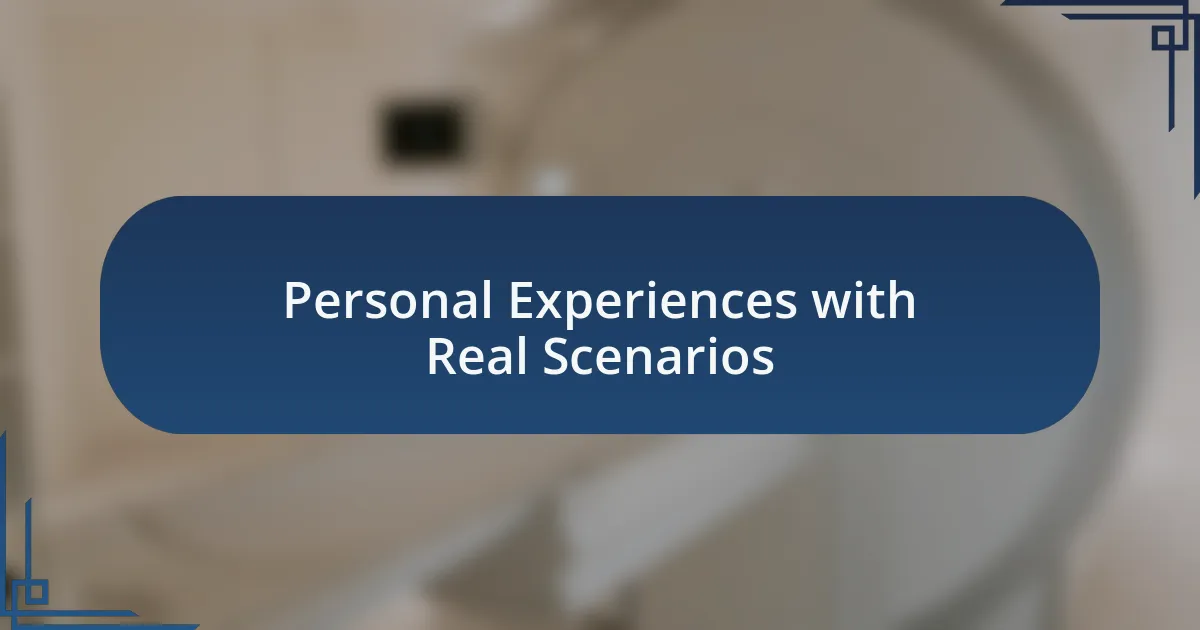
Personal Experiences with Real Scenarios
I remember a particularly challenging scenario during a training workshop where we simulated a mass casualty incident. As I stepped into the role of a triage nurse, my heart raced—there was an overwhelming sense of urgency. The chaos around us was palpable, and I felt the weight of each decision I made for the patients before me. That experience solidified my understanding of prioritization and reinforced how critical clear communication is in high-pressure situations. Have you ever faced that kind of intensity in your training?
Another vivid memory came from a scenario designed around end-of-life conversations. I was tasked with discussing palliative care options with a family reluctant to accept the diagnosis. Initially, I approached the dialogue with trepidation, worried about how to broach such a delicate subject. However, the simulation emphasized that authenticity and compassion are vital tools in these discussions. I found that being genuine in my approach transformed the interaction, making it more collaborative. Have you ever noticed how your tone can shift the dynamic of a conversation?
Finally, working through a scenario involving a patient with complex mental health needs was eye-opening. My initial instincts led me to focus solely on the clinical aspect, yet I quickly realized that understanding the patient’s emotional state was just as crucial. It taught me the importance of a holistic approach to care and that sometimes, simply listening can make all the difference. How often do we find ourselves overlooking the emotional components of patient care in our training?
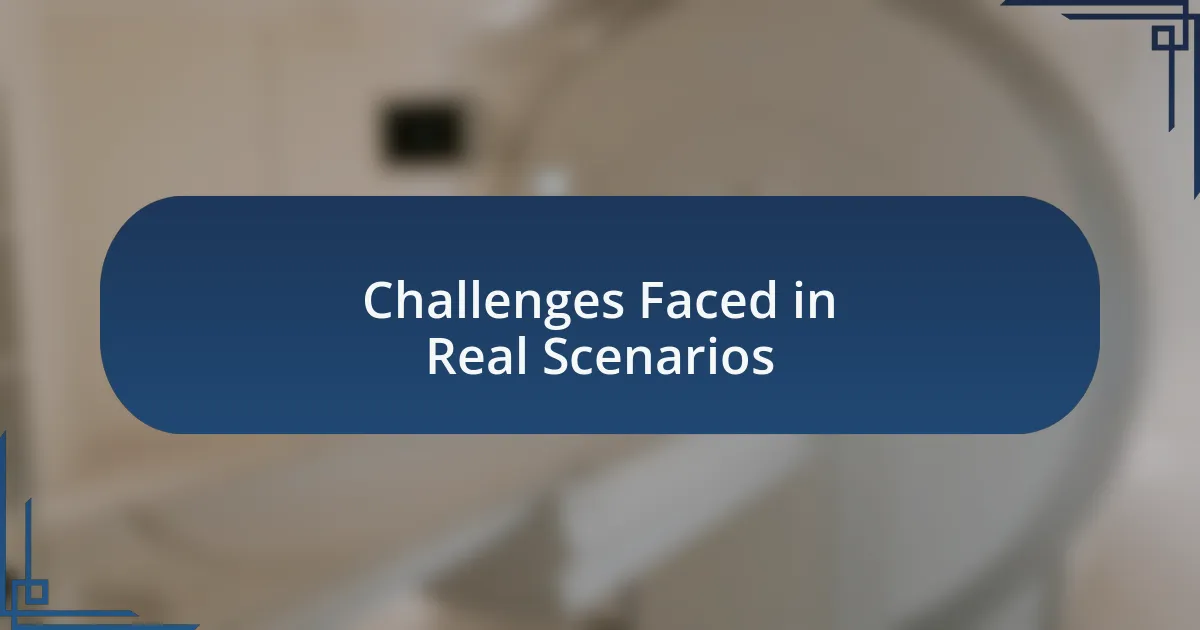
Challenges Faced in Real Scenarios
Navigating real scenarios often brings unexpected challenges that can quickly escalate stress. During one training exercise, I faced a simulated scenario involving a stroke patient. The time pressure to assess and act was intense; I felt my adrenaline spike as I juggled protocols while trying to calm the patient’s anxiety. Have you ever felt the weight of the clock ticking, knowing your decisions could have serious consequences?
Another significant challenge lies in the unpredictability of human behavior. In one instance, I encountered a simulated patient who was uncooperative and confused, rejecting my attempts to provide care. It was a stark reminder that, unlike scripted exercises, real-life situations demand adaptability and emotional intelligence. Reflecting on that experience, I wondered how often do we prepare for resistance, rather than just focusing on the medical aspects of care?
Additionally, the emotional toll of these scenarios cannot be overstated. During a role-play about a traumatic injury, I found myself deeply affected by the plight of the ‘victim’. While I was intended to focus on assessments and management, it became clear that addressing my own emotions was just as essential in delivering compassionate care. Have you ever paused to consider how your feelings can shape your responses in high-stress situations?
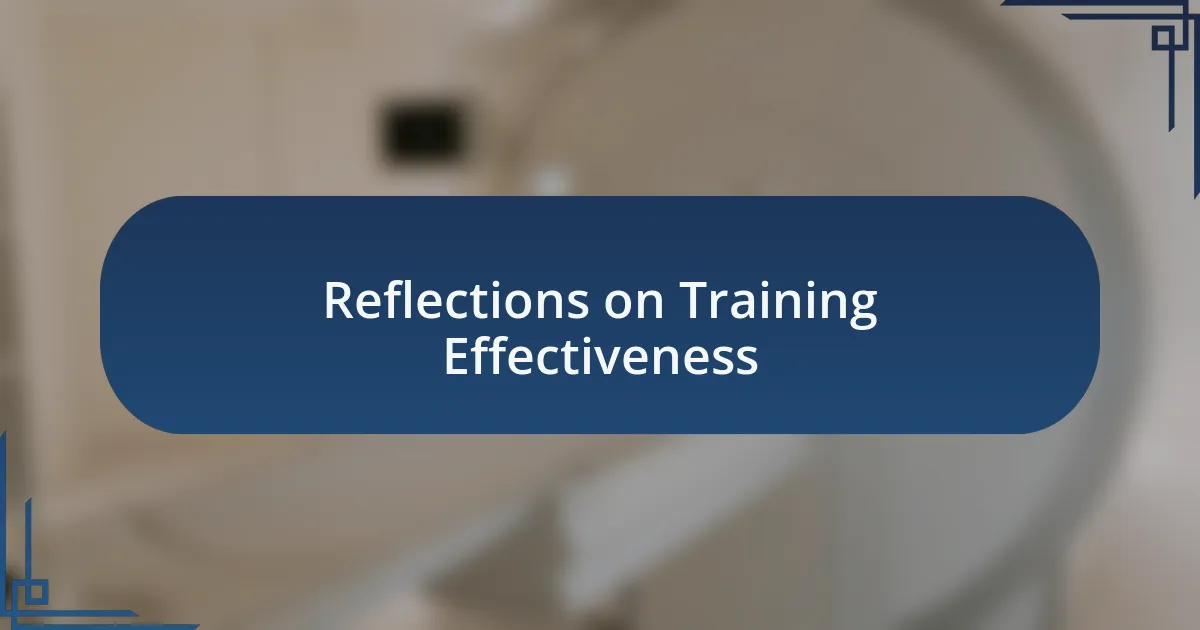
Reflections on Training Effectiveness
Reflecting on the effectiveness of training, I often find that real scenarios push our limits in ways we don’t expect. I remember a training session where I had to lead a team during a mock disaster. It wasn’t just about knowing my role; it was about keeping everyone focused amidst chaos. This experience underscored the importance of teamwork and communication, revealing that the skills we practice in training must translate to real-world effectiveness.
One aspect I’ve observed is how realistic simulations can enhance critical thinking. In one exercise, I had to make rapid decisions while interpreting conflicting test results for a mock patient. The pressure tested my ability to balance clinical reasoning with instinct. When faced with such situations, I often ask myself: How well have I internalized these skills to react effectively in a real emergency? This contemplation drives me to absorb every detail during training, ensuring every lesson counts when it matters most.
The emotional component of training cannot be overlooked. I recall preparing for a scenario involving a tragic healthcare outcome, and the heaviness of the situation weighed on me long after the exercise ended. It was a powerful reminder that effective training isn’t just about technical skills; it’s also about cultivating the emotional resilience needed to handle real-life distress. Isn’t it fascinating how our feelings can inform our approach to patient care?